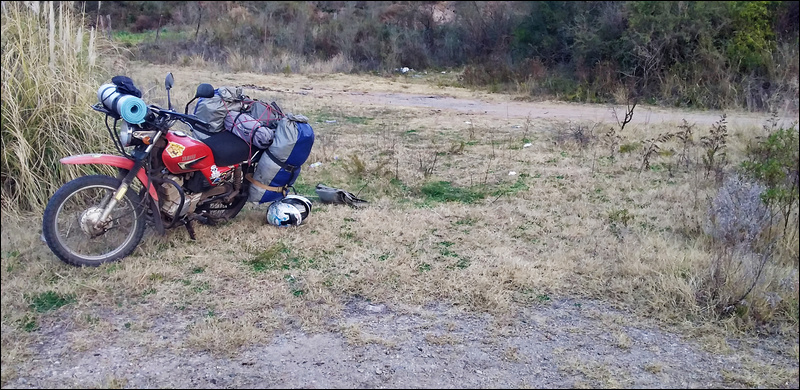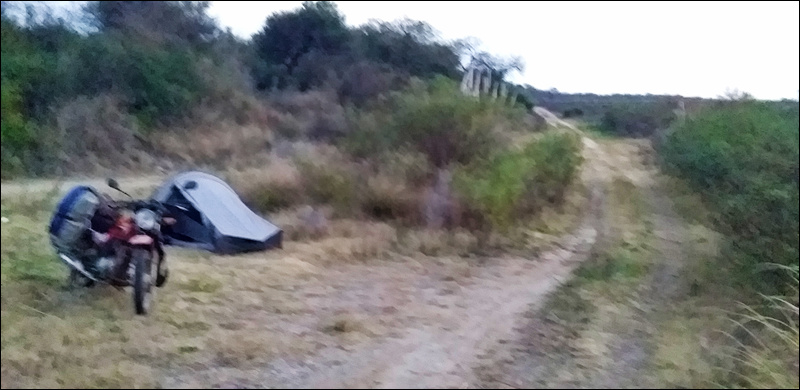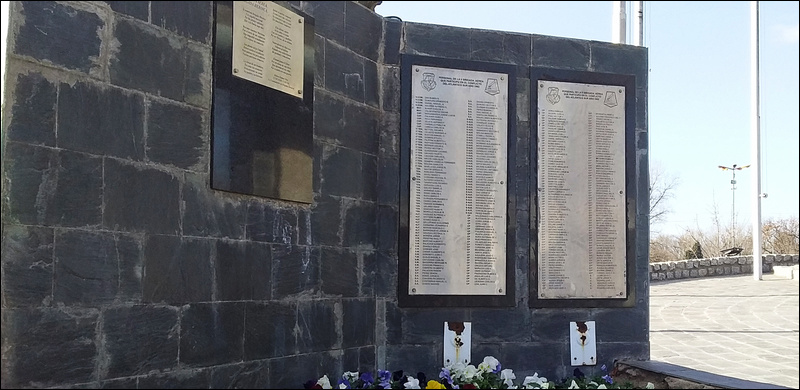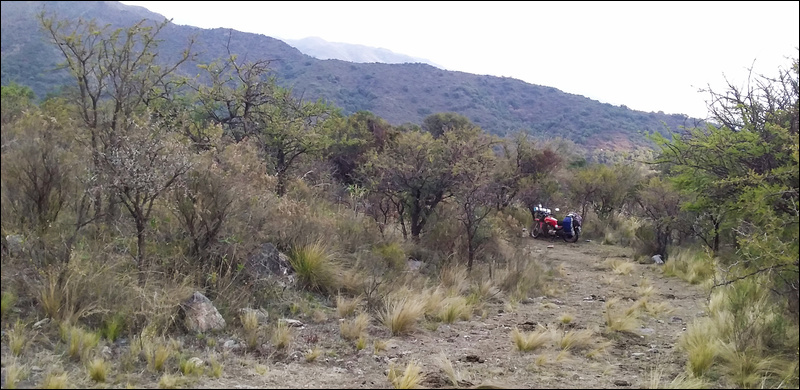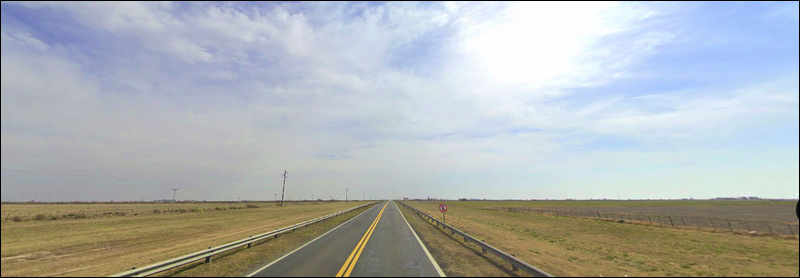
RN7 is a flat and boring grey ribbon of asphalt traversing Argentina between Buenos Aires and Mendoza, squeezed straight by farm fences, slicing up the romantically named Pampas into farmland. Destination today? San Luis.. maybe… 370km is quite a stretch on a 125 especially as I had the setback of being trapped in the field near Rufino this morning. More likely, I could make Villa Mercedes.
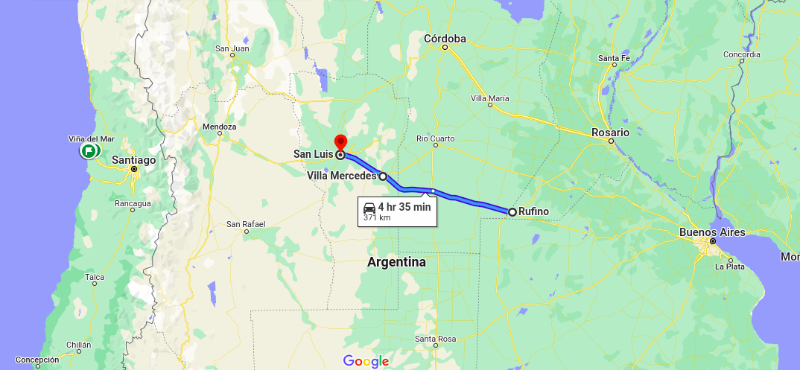
There’s not much to see along the way. Nothing for taking my mind off the increasing numbness planted in my saddle, the cramp in my neck from holding the throttle steady at 80km/h, and the winter wind stream draining what heat I had left in my chilled bones. YPF, the blue and white sign at Argentina’s national gas station is a welcoming site as it looms out of the distance. Usually, decent Cafe con Leche, medialunas (croissants) and WiFi. Stopping for lunch and fuel felt like a real treat, such was the tedium of this dull but efficient route.
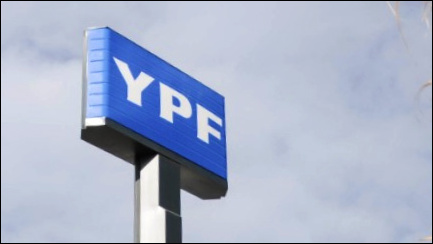
Recharging my tech and warming my hands around a Cafe con Leche, I felt no urgency to proceed. Browsing the iOverlander app, I found a wild camp less than 100km away and just 35km this side of Villa Mercedes. That would do… and still, I would be over halfway across the South American continent munching up these highway kilometres.
Crossing into San Luis province from Cordoba felt like crossing a national frontier. Although I saw no sign of life and nobody stopped me at the checkpoint, the road expanded into an opulent-looking dual-carriageway. This sudden transformation gave the impression of San Luis having more prosperity than Cordoba.
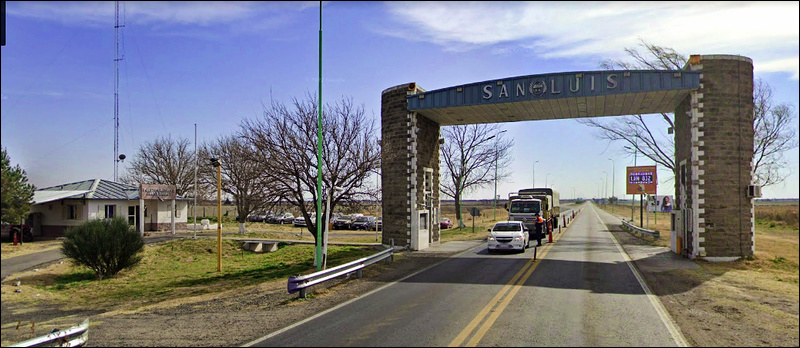
Already late afternoon, I was looking forward to turning off RN7 to make camp just 15km away. The kilometres click around the odometer dial more slowly towards the end of the day. Tapping the dial doesn’t work but shouting “Come on!” in my helmet does. Or at least it cracks open the monotony of the day.

July is pretty much mid-winter in Argentina and although it’s dry, the subtle cooling of the wind stream is relentless as the hours crawl by. Finally, cold and tired, the GPS lines up the left turn I approach the rustic-looking rotunda and swing across the median onto RP11, past the turning heads in Villa Salles to the Rio Quinto. There was the bridge and I veered right down the sand track down to the riverside just before.
This camp spot felt too exposed and the litter around here suggested regular visits, from locals from Villa Salles just up the road or perhaps the larger town of Justo Daract a bit further away. Under the bridge scorched scars of old campfires, crumpled beer cans and coke bottles. Maybe it would do, but the wind tunnel effect beneath the bridge creates a constant breeze in the cool shade. Nah, not a great place to camp. On either side out in the light, the bridge across the river gave a grandstand view over the whole area. There was no escaping any curious eyes that might pass by.
I didn’t like it and powered back up the sandy ramp to the road and turned right across the bridge. Just over the bridge, an anonymous-looking lane to the left curved left and back down to the river far enough to be hidden from the road. I stopped at the side of the road. No traffic so I hung a U-turn and disappeared down the narrow dirt track and swung right parallel to the river obscured by the shrubs far enough around a bend to be not seen from the bridge.
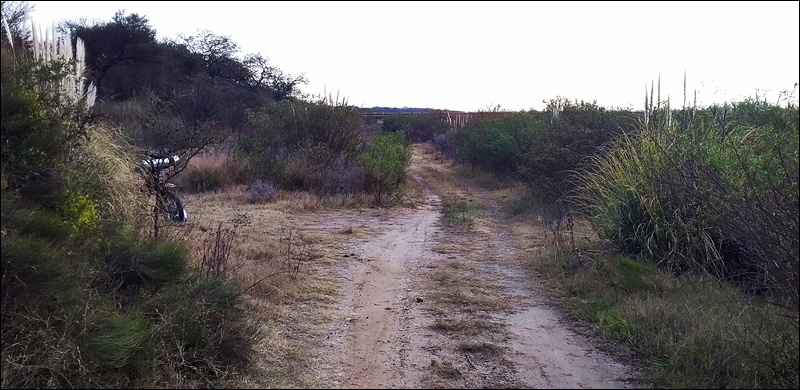
The trail narrowed at a fork. Bearing left, it continued along the river to a wire gate and turning right, led to a gated field that looked like it had scant use. This place was a dead end, perfect for wild camping. The time had already passed 5pm and was definitely public so I wouldn’t get locked in like had been this morning near Rufino so I felt confident I would remain undisturbed overnight.
I couldn’t see the river due to the head-high Pampas grass but it also added privacy from view from the RP11 along the northern bank across the river. I heard a truck rumble north over the bridge and towards Villa Salles but could see nothing of it. Reassured of the site’s privacy, I pitched camp at the fork.
An armadillo scuttled along the lane and disappeared into the pampas grass before I could grab my camera. That would be the last piece of action for the day.
Well rested after a peaceful night, I packed away and cruised to the bridge. The track turned left and rose steeply to join the road at an acute angle. It was impossible to look back for merging with traffic, so I rattled up the incline to join the wrong side of the road before checking. The right-hand bend obscured the view ahead and made this manoeuvre uncomfortable as I wouldn’t be able to see oncoming traffic while I was looking behind, so I stopped as soon as I was off the gravel. This is one of the problems with small engines. It’s hard to stop on inclines and get going again so you have to maintain momentum to reach more firm or level terrain.
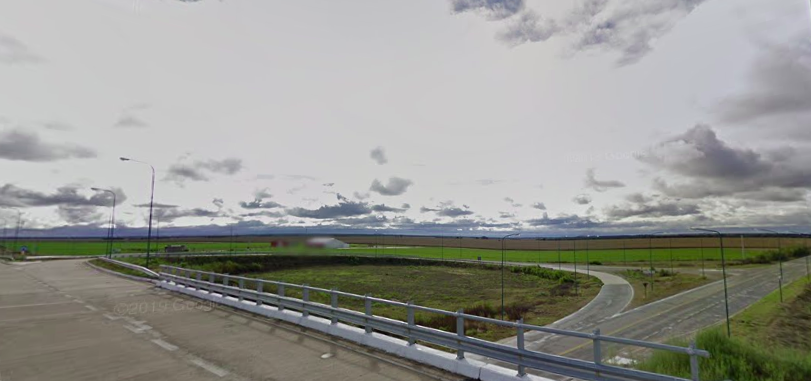
8km later, the RN148 overpass carried the empty dual carriageway over this modest-looking country road, and I peeled right accelerating up the long feeder road. I saw noticed no traffic in the remaining 25km to Villa Mercedes and sat in the morning air listening to the hum of the motor looking forward to brunch in a cosy city cafe.
Entering new cities is usually a tense exercise in multitasking: defensive riding and navigation. But at least the grid layout common to most Latin American cities helps with a general overview for finding directions. With a grid, there are several possible routes to the same destination. Miss a turning? No problem take the next and mentally adjust your route by one block. I just have to keep a sharp lookout for one-way signs and faulty or half-hidden traffic signals. Also, who gives way at unmarked junctions remained a mystery so I coast along using elevated caution, checking my mirrors for impatient locals.
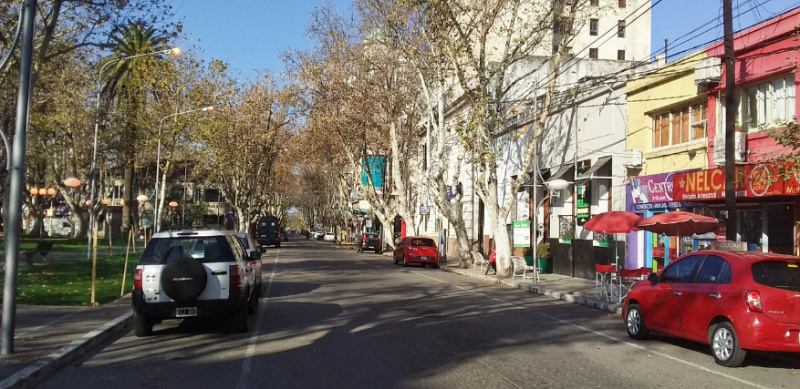
If you see a pair of colonial-looking towers then that’s likely a Cathedral and it usually marks “El Centro” and a green plaza. Villa Mercedes was different. Being bigger than many cities and from between the buildings, I could see nothing. It was case of guess a turning and see what happens. I luckily arrived at Plaza del Sesquicentenario, one of at least half a dozen plazas in Mercedes and a kilometre short of the central Plaza San Martin. It didn’t matter though. This place looked sweet.
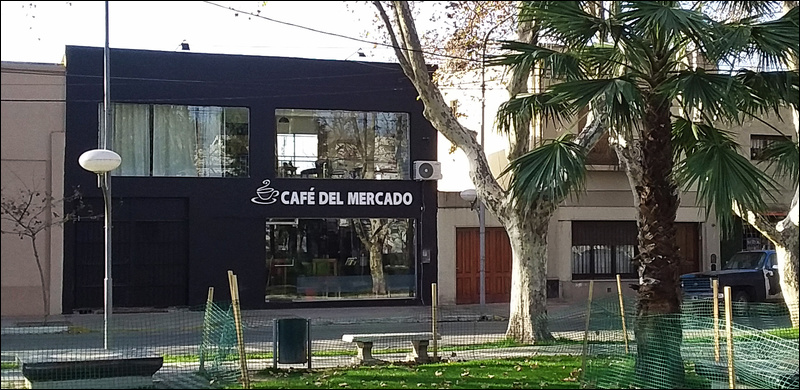
Cafe Del Mercado on the corner of the plaza looked clean and modern with its white graphic of a steaming cup of coffee on a black background. Best of all it looked empty. I parked at the curb and walked through the big glass door taking off my helmet and gloves. A woman was paying her bill at the counter so I quietly took a seat next to an electric socket and view of the bike. I’ve not had a problem but pretty much all I own is strapped to the back of the bike.
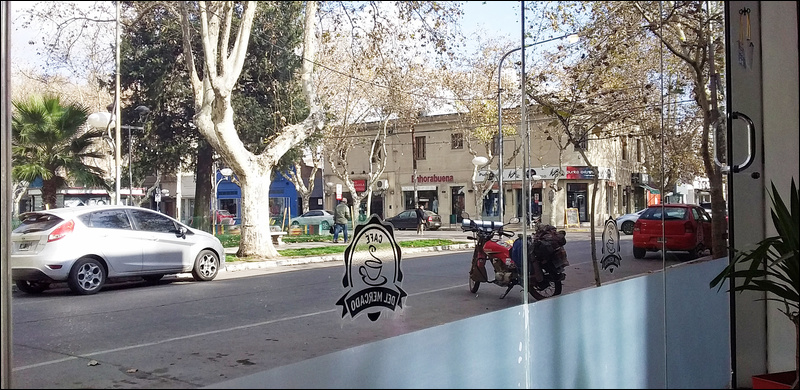
Lauri was about 5’3” with long black hair tied back and wears a warm, friendly smile. The cakes are soft and fresh, the coffee hot and rich and I spent all afternoon there before discovering that the whole town takes a siesta between 1 and 5pm. It was already 3.30 and I was still here. I apologised for staying through their closing time but Lauri seemed happy that I was there. She and Leandro had opened only a few months before so she was still enthusiastic for their business. I felt most welcome and grateful. She told me they had tried staying open all afternoon when they first opened but had no customers between 1 and 5 as they would all disappear until the city started to wake up again so adopted the custom of closing up for the afternoon.
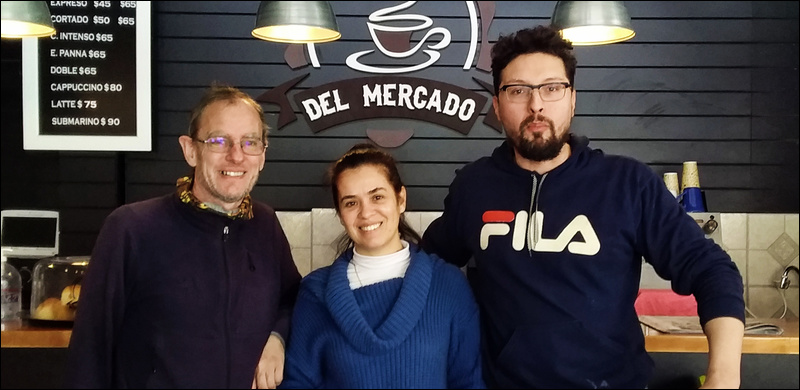
Leandro arrived just as I was starting to leave and Lauri packed me a large bag of medialunas to take with me for free. Leandro pointed me in the direction of some campsites on RP2B just exiting the northwest of the town and recommended on the way to the north that I visit the Malvinas memorial. And tomorrow, instead of continuing along RN7 to San Luis, I should visit Villa de Merlo, a 180km detour to the north. On the map, I could easily see an alternative route from there to Mendoza and it looked more likely to be far more scenic than the trans-pampas RN7 arterial route westward.
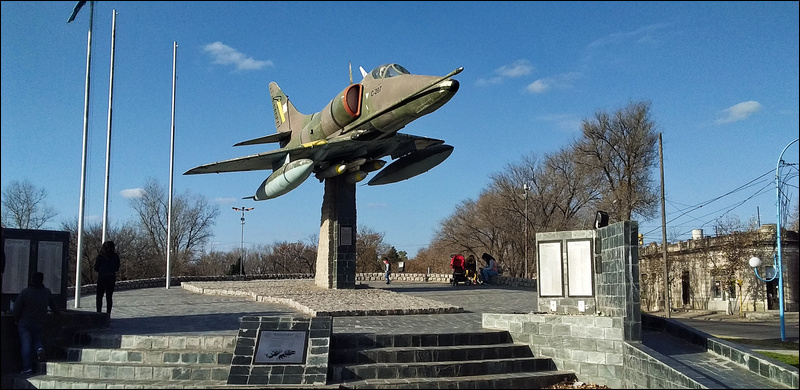
A Douglas A4-B Skyhawk stands on a stone and mortar pillar at the Plaza de la Integracion Verónica Bailone, keeping the Malvinas war in everyone’s memory, day by day. A sad reminder that the power of politics can send ordinary people to kill each other over whatever psychopathic power-seekers can dream up. Wandering around the monument, I could be looked upon as the enemy here even though I had nothing to do with the war – or Margaret Thatcher. I wasn’t even in the UK at the time – I was in Ronnie Reagan’s United States.
Ruta Provincial 2B is another generous and quiet dual carriageway looping out of the northwest of Villa Mercedes to RN7. In its emptiness, I turned across the southbound lane and a disused level crossing, quickly finding Playas del Rio campsite perfectly tranquil and deserted. A middle-aged man in scruffy work clothes approached slowly from a small nearby building
“Cuanto es por la noche?” I asked
“Estamos cerrados excepto el fin de semana” I knew enough Spanish to understand they were only open at the weekend… it was Friday… If it were my business I would have made an exception and happily accepted the revenue and perhaps made it clear that the shower block wouldn’t be open if I was not feeling generous.
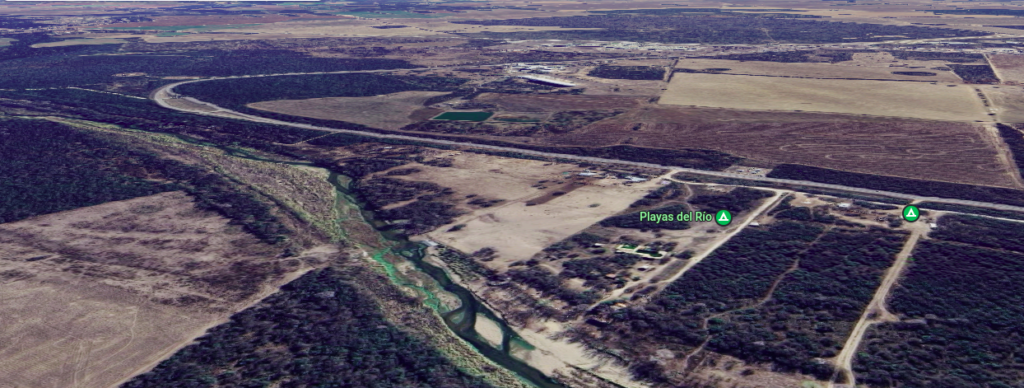
The man pointed down the road indicating another campsite 100 metres away.
“Cien Metros. Camping La Esperanza.” I pulled up at the gate just as a woman was closing it after letting out a beaten-up pickup truck. Same story… closed… only open weekends.

I guess having better language skills could have opened up some negotiation but, as it was, it was easier just to look for somewhere else. I’d noticed a disused railway line between Ruta Provincial 2B and the camping access feeder road. I parked the bike at the roadside near a gap in the bushes and pushed my way through the shrubs to the line. Ancient and overgrown, it was hidden from view from both sides but I could not find any level ground in the weeds and undergrowth.
Remounting the bike I followed the railway line west along RP2B and turned left following the track as RP2B started to curve sharply north. Scanning the dust track for camping opportunities, it veered south towards the river passing a rustic bungalow occupied by two enthusiastic dogs with not much else to bark at as I coasted by to a secluded tree-lined river bank.
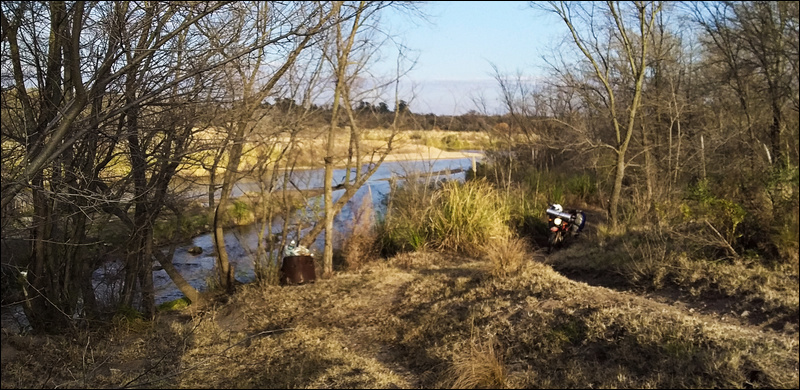
About 50 metres away, the dogs at the house could still sense my presence and carried on barking while I pitched camp. Nobody seems bothered by barking dogs in South America so nobody came to see what I was doing. There was a rusty trash can here, almost full, and litter scattered around suggesting this was a public and reasonably popular spot so I could rest easy that I wasn’t trespassing.
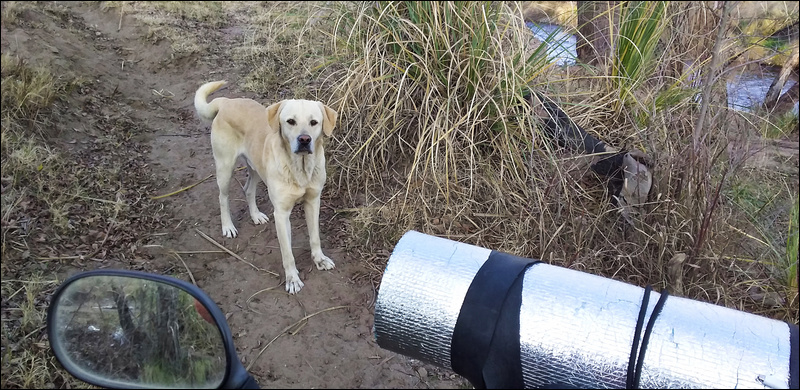
The company of a Labrador Retriever was a minor irritation but he was friendly enough to follow me around probably hoping for food. He stopped barking and stuck around while I did some litter picking to fill up what room was left in the trash can. Plastic bottles were the most common and used diapers were the worst. It’s no good complaining this shit happens all the time.
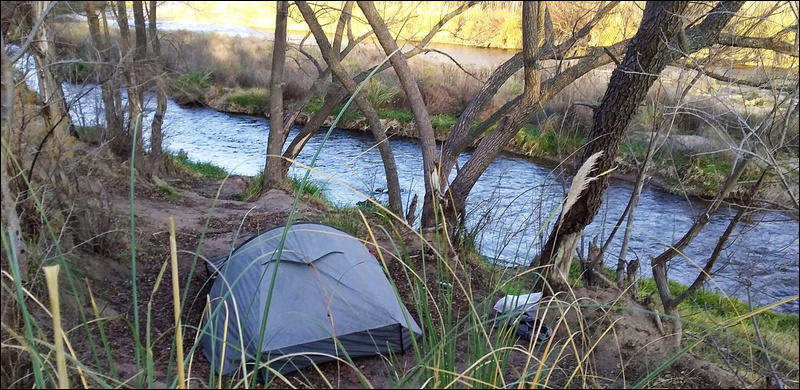
The night was peaceful and the lane quiet. The dogs had settled down after sunset and I feasted on medialunas for dinner while watching an old movie on my laptop. Cool Hand Luke starring Paul Newman.
In the morning I rode back to Cafe del Mercado for breakfast and to socialise with Leandro and Lauri. Leandro showed me around his workshop next door and told me I could camp there if I wanted to stay in Mercedes longer but I’d made up my mind to hit the road north and thanked him and Lauri for making me feel so welcome.
Riding North on RN148 was fast and level just like RN7 but with scenery, and the mountain range to my right in the east slowly rose like a distant tidal wave in a disaster movie. The view already looked well worth the detour.
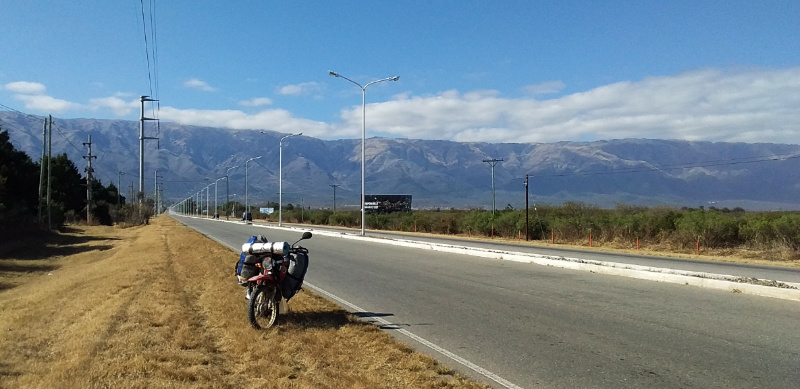
2 hours later, a right turn towards Villa de Merlo led me along Ruta Provincial 5, a wide and fast dual carriageway towards the imposing face of the monumental cordillera. Cheesy, out-of-date posters of local politicians grinned from the verges, looking like secondhand car salesmen trying to look as honest as possible but craving a vote from the locals instead of selling dodgy machinery. It gave me the feeling that this was a place of power and money.
Villa de Merlo is a smart and bustling town looking prosperous from tourism from the wealthy porteños from Buenos Aires. I continued through the town, and tagged onto the traffic snaking through the one-way system while scanning for a camping spot for the night.

The Camping Municipal on the far side of town was still too urban and far too close to RP5 and I emerged from the edge of the town to start climbing steeply into the cordillera. A short way up, a right turn down a stony path offered itself for exploration. It soon narrowed and condensed into a rough horse trail between thorny shrubs and I found a perfect opening hidden from view where the trail forked either left up the mountain or continued on away from the road. A gaucho trotted past, after I had pitched camp, leading a string of saddled horses and wishing me “Buenas tardes!”
I couldn’t see anything down that way but presumed he was continuing to his home somewhere along the mountainside and to rest his horses for the night.

The sun sank slowly over the distant westward horizon and I settled into a cool and peaceful mountain night hidden in the bushes over the twinkling lights of Villa de Merlo.
